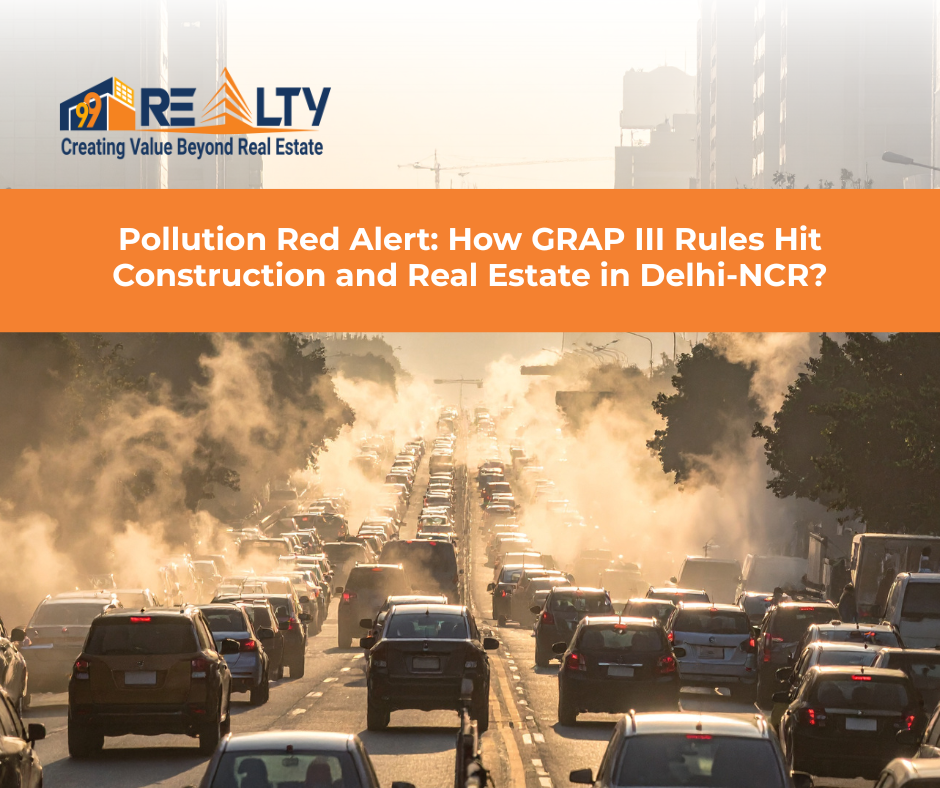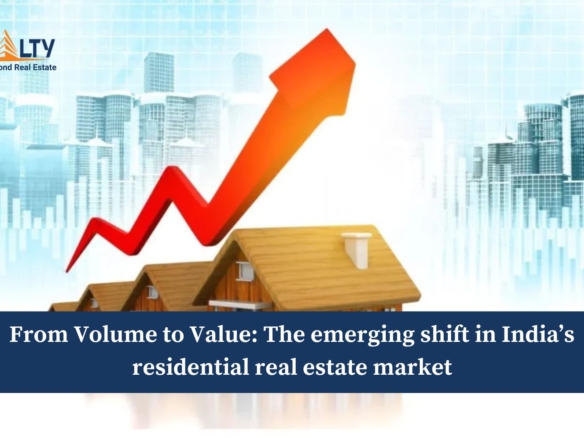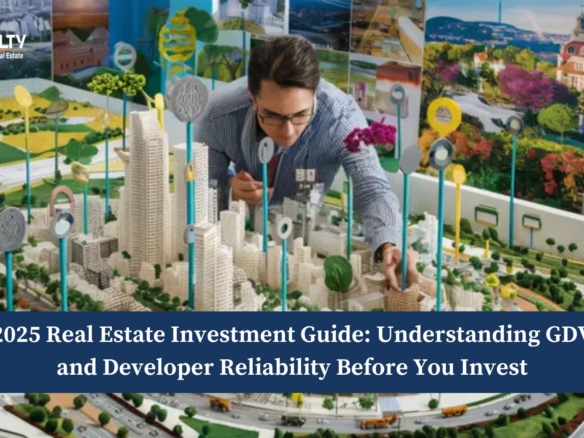Delhi-NCR’s air has always been a challenge — but when the smog thickens and the AQI spikes, it’s no longer just an environmental nuisance. It becomes an economic earthquake. With GRAP Stage III now in force, construction sites across the region are grinding to a halt, and the real estate world is bracing for one of its most dramatic disruptions in years.
This isn’t just another regulation — it’s a live wire, pulling the plug on construction activity, shaking cash flows, and raising serious questions for developers, investors, and homebuyers alike.
How Construction Quality Impacts Your Investment?
The Real Stakes for Real Estate — Not Just an Environmental Story
While the headlines scream “pollution emergency,” the real estate industry knows what this means in Rupees and days. Every day lost in construction means mounting costs. Every delayed handover erodes buyer confidence. For an industry that thrives on momentum and timelines, GRAP III is less of a slowdown — it’s a full stop, with ripple effects that could last far longer than the smog itself.
What Is GRAP? A Quick Refresher
To understand why this moment matters so much, we need to go back to the basics: what GRAP is, how it works, and how its different stages affect not just the air — but the economy.
The Four Stages of GRAP (I, II, III, IV)
The Graded Response Action Plan (GRAP) is a tiered policy mechanism aimed at controlling severe air pollution in Delhi-NCR. It’s triggered based on real-time AQI readings, and it features four escalating stages of restrictions.
Here’s a breakdown:
- Stage I (AQI 201–300) — A warning phase, focusing on dust control, monitoring industrial emissions, and issuing health advisories.
- Stage II (AQI 301–400) — More aggressive measures: increased road sweeping, water sprinkling, curbs on diesel generators, and boosted public transport.
- Stage III (AQI 401–450) — The “severe” alert: non-essential construction is banned, key industrial activities restricted, and vehicle curbs imposed.
- Stage IV (AQI > 450) — The emergency mode: maximum restrictions on vehicles, construction, and movement
How GRAP Works on the Ground
Who Decides When to Trigger a Stage — CAQM & Real-Time Data
The Commission for Air Quality Management (CAQM) plays a central role. It uses real-time air quality data, meteorological forecasts (often from IMD and IITM), and predictive models to decide when to move the dial up or down.
This means GRAP isn’t just reactive — it’s proactive and dynamic. Authorities try to anticipate pollution spikes and enforce measures in advance, rather than waiting for a full-blown crisis.
On-the-Ground Measures: Dust Control, Traffic, Industry Shutdowns
Depending on the stage:
- Mechanical sweeping and water sprinkling are ramped up to suppress road dust.
- Polluting vehicles, especially older diesel ones, face entry restrictions.
- Construction sites are monitored (or shut down) to control dust and emissions.
- Industrial operations, including stone crushers and certain brick kilns, are curtailed under higher stages.
GRAP II vs GRAP III vs GRAP IV: What’s Different
This is where things get very real for real estate.
Comparing the Restrictions — A Side-by-Side Breakdown
GRAP II Actions — Moderate Curbs, More Public Transport, Road Sweeping
Under Stage II, the focus is on preventive and control measures, rather than hard shutdowns. Key actions include:
- Daily mechanical or vacuum sweeping on major roads.
- Water sprinklers to dampen dust, especially in high-traffic and high-dust zones.
- Enhancing public transport — more CNG/electric buses, higher metro frequency — to reduce reliance on private vehicles.
- Restrictions or reduced use of polluting diesel generators during demand peaks.
GRAP III – Construction Freeze, Industrial Shutdown, Vehicle Limits
Stage III steps up dramatically:
- Non-essential construction and demolition are banned.
- Industries like stone crushers and brick kilns face curbs or shutdowns.
- Entry restrictions for older diesel and petrol vehicles to reduce emissions.
- Increased mechanized road cleaning remains, but with more urgency.
GRAP IV — Maximum Emergency, Even More Restricted Movement & Construction
When pollution tips into “Severe Plus” (AQI > 450):
- Even stricter vehicle curbs — potentially banning many non-essential vehicles.
- Construction could be banned or severely limited, including public infrastructure work.
- Public advisories could encourage work-from-home; schools may shift modes depending on severity.
Why GRAP Matters for the Real Estate Industry
GRAP III (and even the looming threat of IV) is not just an air-quality issue — it’s a real estate shockwave.
Construction on Hold — As Construction and Demolition activities restricted
Imagine cranes stopping mid-lift, construction workers walking away from sites, and trucks loaded with materials standing idle. That’s what a GRAP III trigger effectively does. The cost to developers is not just in delayed timelines but also in idle capital, rental overheads, and resource wastage.
Branded Vs Local Developers/Builders : Which One Truly Delivers Value?
Labor Risk — Thousands of Workers Affected Overnight
The construction workforce absorbs the first blow. When sites shut down, laborers — particularly migrant and daily wage workers — lose income. This isn’t just a business risk; it’s a social risk that could escalate if GRAP triggers become frequent.
Cash Flow Crisis — Delays = Higher Costs, Liquidity Crunch
Projects run on tight schedules. Delays mean that cash “in” slows or stops, but cash “out” (for logistics, salaries, equipment) doesn’t just vanish. Developers may scramble to renegotiate loans or push back milestone payments — an unpleasant dance that can strain finances and relationships with buyers.
Strategic Responses from Developers
Despite the disruption, many developers are not just waiting. They’re strategizing.
Pushing for Site-Specific Relief (Why Not Everything Should Be Shut)
Real estate bodies are calling for site-specific exemptions, especially for RERA-registered projects, which are typically more compliant with environmental norms. Such projects could be classified as “essential,” letting some construction continue with safeguards.
Real-Time Pollution Monitoring on Construction Sites
Developers want to install real-time AQ sensors at construction sites, arguing that if pollution is kept under control there, they should be allowed to operate even during a GRAP III period. It’s not just a demand — it’s a data-driven solution that aligns with GRAP’s own reliance on real-time air-quality data.
Opportunities Amid the Crisis
Even in a crisis, opportunity can bloom — especially for forward-thinking players.
Innovation in Construction & Real Estate Tech
Low-Dust Construction, Modular Methods
Companies that innovate — by using modular building, pre-cast elements, or monolithic concrete — can reduce site emissions. This not only helps during GRAP III but also improves long-term efficiency.
Green Certifications & ESG Positioning
Real estate developers focusing on environmental credentials can use this moment as a competitive advantage. Green-certified projects may attract premium buyers or ESG-focused investors.
Strategic Investments & Timing the Market
As the dust (literally) settles, some investors may see GRAP III as a strategic entry point. Developers who maintain compliance and invest in clean tech could be well-positioned when restrictions ease. Real estate in Delhi-NCR built with sustainability in mind may emerge as a premium, resilient asset class.
Conclusion
The imposition of GRAP Stage III in Delhi-NCR is undoubtedly a big deal for real estate. It’s not just an environmental regulation — it’s a stress test for builders, buyers, and policymakers alike. While the short-term consequences — delays, costs, and labor disruption — are real, there’s also a powerful opportunity: to reshape how construction works, how projects are planned, and how sustainability is baked into the DNA of real estate.
If developers, regulators, and stakeholders can work together — employing data-driven regulation, site-specific decisions, and greener construction — this moment could mark a turning point. It’s a tough balancing act, but getting it right could deliver cleaner air and stronger, more responsible real estate for the future.
Need Help?
Need help evaluating a property or planning your next move in the market?
Reach out to 99 REALTY – your trusted real estate partner for smarter choices.
Subscribe to get updates on our latest posts and market trends.






Join The Discussion